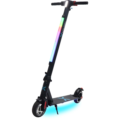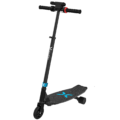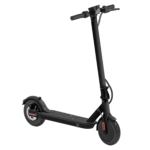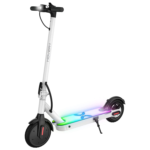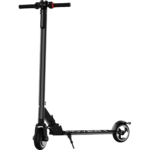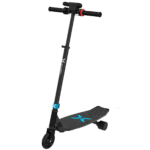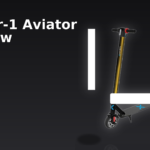- Home
- Scooters
- Electric Scooters
- Hover-1 Renegade
Hover-1 Renegade



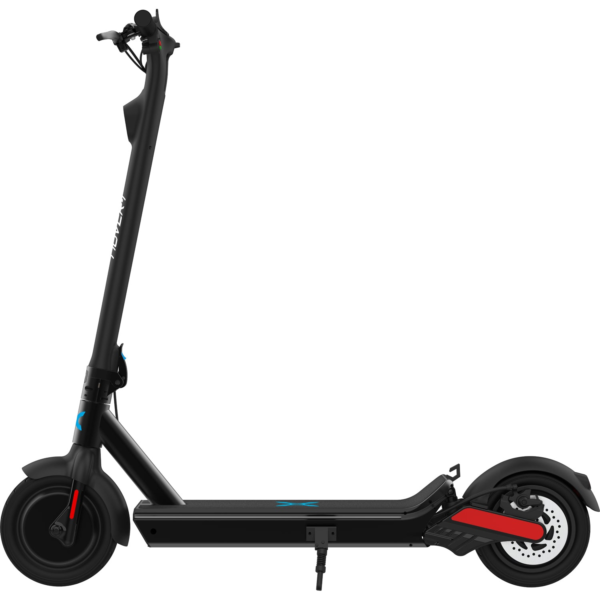
- Battery Range: 27 miles (43 km)
- Top Speed: 28 mph (45 km/h)
- Motor Power: 2 × 450 W (dual)
- Weight Capacity: 300 lb (136 kg)
- Charging Time: ≈7 h
- Scooter Weight: 46.3 lb (21.0 kg)
PROS
- Dual 450 W motors (2WD)
- 28 mph top speed
- 10″ pneumatic tires
- Rear disc brake
- Turn signals and lighting
CONS
- Front brake not listed
- IP rating not listed
- Heavier to carry
Table of contents
- What Is the Hover-1 Renegade?
- How the Hover-1 Renegade Works
- Key Specifications
- Design & Build Quality
- Performance Fundamentals
- Battery, Range & Efficiency
- Ride Quality & Comfort
- Braking & Safety Features
- Portability & Daily Usability
- Maintenance & Care
- Weather & Seasonal Considerations
- Hover-1 Renegade vs Alternatives
- Who the Hover-1 Renegade Is (and Isn’t) For
- FAQs
- Glossary
- Final Thoughts
The Hover-1 Renegade is a dual-motor, folding electric scooter built for short urban trips and weekend fun. It combines 10-inch pneumatic tires, a rear disc brake, and a 54V battery in a package that remains portable enough for apartments and car trunks. For shoppers cross-shopping the Hover-1 Alpha, the Renegade adds dual-motor traction and livelier acceleration while staying approachable for new riders. Consequently, riders who want a steady, confidence-building starter scooter with a bit more punch than single-motor commuters will feel at home on the Hover-1 Renegade.
What Is the Hover-1 Renegade?
At its core, the Hover-1 Renegade is a two-wheel personal transporter with two 450W hub motors (900W total nominal rating) and a 54V lithium-ion battery. Moreover, it’s designed around simple, reliable controls: an electronic handlebar throttle, an LED digital display, and a rear mechanical disc brake. The frame folds at the stem to simplify storage. Meanwhile, ten-inch air-filled tires add compliance over cracked pavement, while integrated lights improve low-light visibility. The scooter is rated for riders up to 264 lb (120 kg) and a top speed up to 18 mph (29 km/h), which places it above basic last-mile models yet below heavy performance machines.
How the Hover-1 Renegade Works
Every control on the Renegade is straightforward. First, twist the power on, step onto the deck, kick to about 3 km/h (≈1.8 mph), then roll on the electronic throttle. Next, the scooter’s controller meters battery power to each hub motor, smoothing starts and steady cruising. Think of it like a dimmer switch on a light circuit—more throttle equals more current, which wakes the motors.
Power comes from a 54V battery sized at 11.6Ah (about 626 Wh). In practice, voltage determines how lively acceleration feels, while capacity determines how far you can travel on a charge. When you release the throttle, the motors coast down, and the rear disc brake provides the firm stop you need at the end of the block or when someone steps out unexpectedly. Additionally, lighting and the LED digital display draw very little energy, so they don’t meaningfully reduce range.
Because the Renegade uses pneumatic (air) tires, they act like small shock absorbers. Therefore, they flex over seams and expansion joints that would rattle a solid-tire scooter. Finally, the folding stem latch locks the front assembly upright for riding and collapses quickly for storage, which streamlines daily use.
Key Specifications
Below are the official specifications presented in both US and metric units for immediate comparison. These values are manufacturer-rated and intended for planning, not guarantees in all conditions.
| Block | Item | Details (US / Metric) |
|---|---|---|
| General | Model | Hover-1 Renegade (H1-RENE) |
| Rider Weight Limit | 264 lb / 120 kg | |
| Recommended Age | 16+ years | |
| Scooter Weight | 46.3 lb / 21.0 kg | |
| Performance & Power | Motors | Dual 450W brushless hub motors (900W total nominal) |
| Top Speed | Up to 18 mph / 29 km/h | |
| Claimed Range | Up to 33 miles / ~53 km | |
| Climbing Claim | Up to ~15° inclines (short bursts) | |
| Tires | 10 in pneumatic (≈254 mm), road pattern | |
| Battery, Charging & Electrical | Battery | 54V 11.6Ah lithium-ion (≈626 Wh) |
| Charging Port & Time | Single-pin charger; up to ~7 hours from low | |
| Operating Temp | ~32–104 °F / 0–40 °C (typical) | |
| Display | LED digital speed/battery display | |
| Lighting | Headlight (front), rear light | |
| Audio | Integrated Bluetooth® speaker | |
| Build & Dimensions | Folding | Single-level folding stem latch |
| Unfolded Size (L×W×H) | 47.5 × 20.5 × 44.7 in / 120.7 × 52.1 × 113.5 cm | |
| Folded Size (L×W×H) | 47.5 × 20.5 × 12.0 in / 120.7 × 52.1 × 30.5 cm | |
| Deck | Full-length standing deck with grip | |
| Safety & Control | Brake | Rear mechanical disc + motor cut on throttle release |
| Start Method | Kick-to-start around 3 km/h (≈1.8 mph) | |
| Reflectors | Not factory-equipped; use lights and high-vis gear | |
| Features & Extras | Display Features | Speed, battery status at a glance |
| Cruise Control | Not specified by manufacturer | |
| Accessories | Bell/hand controls vary by market bundle | |
| Warranty & Compliance | Warranty | 1-year limited (parts & labor; exclusions apply) |
| Compliance | Typical consumer electronics compliance (e.g., FCC) | |
| Water Ingress | No IP rating claimed; avoid rain and puddles |
Note: The specifications above are manufacturer-rated. Real-world results vary with rider weight, terrain, temperature, and maintenance.
Design & Build Quality
The Renegade follows a practical, compact layout. Specifically, the folding stem sits at a comfortable height for most adult riders, and the cockpit concentrates essentials—power, throttle, display, and brake lever—where your hands naturally rest. You get a clear LED digital display that’s readable in daylight and remains gentle on the eyes at night. Furthermore, the deck is long enough for a natural stance, letting you shift your weight forward for starts and back for braking.
Fit-and-finish is tidy for this class. Panel gaps stay consistent, and the wiring is routed with basic strain reliefs at the bars and deck entry. In addition, the 10-inch pneumatic tires are a meaningful upgrade over 8–8.5-inch urban tires, because they roll over pothole edges with less sharp impact. The rear disc brake caliper and rotor are protected from toe strikes, and rotor rub is easy to diagnose by sound during a spin test. Likewise, the stem latch closes decisively and includes a safety catch to prevent accidental collapse. You’ll feel slight stem flex if you lean hard on the bars at a standstill; however, in motion, it settles and becomes a non-issue at neighborhood speeds.
Overall, build choices reflect the product goal: give new riders stable handling and simple controls without a learning curve. As a result, there are no exotic materials or hidden shocks to service, which keeps ownership simpler for first-time scooter owners.
Performance Fundamentals
Acceleration feel. With two 450W motors, starts are confident but not abrupt. From a rolling kick, the throttle feeds power smoothly. Because voltage is 54V, the scooter holds speed on flat ground with less sag than many entry-level single-motor models. Consequently, it feels most composed at 12–16 mph (19–26 km/h), where steering inputs are natural and the deck stays calm.
Cruising stability. The Renegade tracks straight once you align your stance. Moreover, the 10-inch tires reduce twitchiness, so small bumps don’t yank the bars. Above about 18 mph (29 km/h), the scooter is at its limit and signals that through gentle bar lightness; thus, most riders will settle just below top speed for comfort. Wind gusts nudge the front end but rarely push it off line if you keep arms loose.
Hill behavior. On ~7–10% grades, momentum matters. Kick to start, then maintain throttle as you crest. Short, steeper driveway ramps are manageable if you hit them with speed; the scooter is rated to tackle up to ~15° briefly, but sustained steep climbs will slow it. As always, rider weight and state of charge make a noticeable difference; therefore, plan speed before the incline.
Battery, Range & Efficiency
The battery is 54V 11.6Ah (~626 Wh). At low urban speeds with a lighter rider and smooth pavement, the scooter can approach its up-to-33-mile (53 km) claim. However, conditions define outcomes. Heavier riders, hills, cold weather, soft tires, stop-and-go patterns, and carrying a backpack all reduce practical range.
To maximize efficiency:
- Ride at steady speed. Frequent full-throttle bursts waste charge. Therefore, smooth inputs pay off.
- Keep tires inflated. Under-inflated pneumatic tires add rolling resistance and lower range; consequently, check PSI often.
- Charge smart. Topping from 40–80% for day-to-day rides reduces time at extremes. For longer trips, fully charge beforehand.
- Consider temperature. In cold weather, you’ll notice range loss. Nevertheless, batteries warm slightly during use, so the second half of a ride can feel livelier than the first winter mile.
Charging from low to full takes up to ~7 hours using the included single-pin charger. For safety, place the charger on a hard surface in a ventilated space. As with any lithium-ion pack, store the scooter in a dry area away from heat sources. If you plan to park for weeks, leave the battery around mid-charge; similarly, cycle it to about 60% every few weeks.
Ride Quality & Comfort
The Renegade’s pneumatic tires do the heavy lifting for comfort. They round off the chop from expansion joints and make rough asphalt feel less buzzy. Consequently, you should keep them at the pressure printed on the tire sidewall. Low pressure increases pinch-flat risk and steals range, while over-inflation sharpens impacts.
There is no complex suspension system to tune. Instead, rider posture and stance matter. Bend your knees over broken pavement and keep your arms slightly relaxed to let the chassis float under you. Stem flex is minimal at neighborhood speeds and doesn’t intrude. Meanwhile, the deck offers enough real estate for a staggered stance with feet shoulder-width apart, which helps stability during braking and cornering.
Ergonomically, controls fall to hand. Lever travel is short and predictable, and the throttle is easy to modulate while maintaining a firm grip. Additionally, the LED display gives you speed and battery status at a glance so you can pace yourself on longer rides.
Braking & Safety Features
The rear disc brake is the primary stopping tool. It engages with a firm lever pull and bites cleanly once the pads bed in. Expect longer stopping distances than high-end hydraulic systems; therefore, plan ahead and make two-finger braking a habit. Releasing the throttle before braking shifts weight rearward and smooths weight transfer.
Lighting includes a front headlight for low-light commuting and a rear light to announce braking and presence. Even so, visibility is your responsibility; consider reflective clothing or stick-on reflectors if you ride at dusk, because the Renegade does not ship with dedicated reflector panels. The scooter’s kick-to-start logic reduces unintended launches by requiring a small push before the throttle activates.
Water protection is not rated. Consequently, avoid heavy rain, standing water, or wash-downs. Moisture can corrode connectors or infiltrate housings over time. If you get caught in a drizzle, wipe the scooter dry and store it indoors.
Portability & Daily Usability
At 46.3 lb (21 kg), the Renegade is carryable for a short flight of stairs or into a trunk, but it’s not a featherweight. Nevertheless, the single-level folding mechanism is quick; fold the stem, secure it, and you can elevator-carry or slide it behind a seat. The folded footprint of 47.5 × 20.5 × 12 in (120.7 × 52.1 × 30.5 cm) fits most compact car trunks diagonally.
For city life, lock strategies matter. Because scooters use aluminum and hollow stems, never rely on a single cable lock through the wheel. Instead, combine a sturdy lock through the deck or a fixed anchor point with a secondary deterrent for wheels. Better yet, bring it indoors at work or school. Finally, keep a soft cloth and small brush by the door; a 30-second wipe prevents grit from migrating into hinges and levers.
Maintenance & Care
A light, regular routine keeps the Renegade tight and quiet.
Before each ride (30–60 seconds):
- Check tire pressure to the sidewall rating with a handheld gauge. Additionally, confirm valve caps are snug.
- Squeeze the brake lever; confirm solid feel and rotor clearance.
- Glance at the latch; ensure the stem lock is fully seated.
- Power on, cycle the lights, and confirm display readouts.
Weekly (10 minutes):
- Inspect brake pads for wear; adjust cable tension if the lever travel grows long.
- Spin the wheels; listen for rotor rub and true the caliper if needed.
- Check fasteners on the stem hinge, caliper mounts, and handlebar clamp. Tighten to snug, not gorilla-tight.
- Clean the deck and wipe dust off the display and lights. Likewise, brush debris out of the latch area.
Monthly (15–20 minutes):
- Inspect tire tread and sidewalls for cuts.
- Evaluate battery behavior. If range seems to drop unexpectedly, note ambient temperature and inflation; both strongly affect distance.
- Review charging habits. Avoid leaving the charger connected for days; once full, unplug. Similarly, let the scooter cool before charging after a hot ride.
Avoid pressurized water. If the scooter gets splashed, dry connectors and housings with a towel and allow air to circulate before charging.
Weather & Seasonal Considerations
Rain. The Renegade has no published IP rating, so treat water as the enemy. If you must ride after a sprinkle, slow down, brake early, and avoid puddles. Then, dry the scooter as soon as you’re indoors.
Heat. High temperatures push battery temperatures up, reducing life over time. Therefore, park in the shade and let the scooter cool before charging after a hot ride.
Cold. When the thermometer dips, range shrinks. Plan shorter routes and consider pre-warming the scooter indoors. Also, inflate tires toward the higher end of the printed range in cold, since pressure drops with temperature.
Traction. Painted crosswalks, leaves, and metal plates become slick in the wet. Thus, enter turns gently and keep eyes up; line choice matters more than throttle in slippery conditions.
Hover-1 Renegade vs Alternatives
The Renegade bridges entry-level commuters and bigger performance scooters. Compared with basic last-mile models, it offers dual-motor sure-footedness, more stable 10-inch rollers, and longer range potential. Therefore, it rewards smooth riders who want a dependable neighborhood machine with room to grow skills.
Against heavier performance scooters with hydraulic brakes and suspension, the Renegade is simpler, lighter, and easier to live with. There’s less to tune, fewer parts to service, and no complex shock hardware to rebuild. You trade outright top speed and heavy-duty braking for portability and a calmer ownership experience.
If your rides are mostly five to ten city blocks with a couple of mild hills, the Renegade’s balance of pace, comfort, and practicality shines. Conversely, if you routinely face steep grades, long descents, or speeds above neighborhood limits, a higher-tier platform with bigger brakes and formal water protection may be more appropriate.
Who the Hover-1 Renegade Is (and Isn’t) For
Great for:
- Students and campus riders who value easy controls, a stable deck, and dependable lights.
- Short-to-medium commutes on decent pavement with modest hills.
- New riders who want the security of dual motors without the bulk and cost of performance giants.
- Apartment dwellers who need a scooter that folds and tucks away.
Less ideal for:
- Rain-or-shine commuters, because there’s no water ingress rating.
- Very long ranges at high speeds; capacity is healthy, yet not designed for cross-town sprints day after day.
- Riders demanding hydraulic brakes or full suspension, which add weight and complexity the Renegade avoids.
FAQs
1) How fast does the Hover-1 Renegade go?
It’s rated up to 18 mph (29 km/h) on flat ground with a charged battery and a typical rider. Consequently, expect best results with steady throttle.
2) What is the real-world range?
Expect less than the up-to-33 miles (53 km) claim if you’re heavier, ride fast, face hills, or ride in cold weather. Even so, careful throttle use and firm tire pressures help.
3) Can I ride the Renegade in the rain?
It has no published IP rating. Therefore, avoid rain, puddles, and wash-downs. Moisture can damage electronics over time.
4) Does the scooter have cruise control?
Cruise control is not specified. Accordingly, plan to hold steady throttle on longer stretches.
5) How steep a hill can it climb?
Short, steeper bursts are manageable with speed. For longer climbs around 7–10% grade, expect slowing; rider weight and state of charge matter.
6) What does “kick-to-start” mean?
The throttle won’t engage from a standstill. Thus, give a small kick to around 3 km/h (≈1.8 mph), then the motor assistance activates.
7) Where can I find a quick Hover-1 Renegade overview?
You’re reading a Hover-1 Renegade overview right here: design, performance, range, and ownership tips in one place.
Glossary
- Ah (Amp-hours): Battery capacity. Higher Ah usually means more potential range.
- Wh (Watt-hours): Battery energy (V × Ah). Consequently, it’s useful for comparing total battery size.
- Controller: Electronics that meter power from battery to motors in response to throttle.
- Brushless hub motor: Efficient motor built into the wheel hub; low maintenance.
- Kick-to-start: Safety logic requiring a small push before throttle activates.
- Regen: Regenerative braking that recharges the battery while slowing; not advertised here.
- Stem flex: Small, normal deflection in the folding stem under load.
- IP rating: Ingress Protection code for dust/water resistance; none claimed for this model.
- PSI: Pounds per square inch; tire pressure unit used on sidewalls.
- Disc brake: Caliper squeezes a metal rotor to slow the wheel.
- Pneumatic tire: Air-filled tire that cushions road impacts.
- Grade/Incline: Hill steepness; often listed as percent or degrees.
- Thermal sag: Temporary performance drop when components heat up under load.
- BMS: Battery Management System that monitors charging and discharging health.
- Nominal power: Sustained motor rating; peak bursts can be higher but brief.
Final Thoughts
The Hover-1 Renegade strikes a smart balance for new and intermediate riders. It blends dual-motor traction, 10-inch pneumatic comfort, and simple maintenance into a tidy fold-and-go package. If you keep it on good pavement and respect its wet-weather limitations, it will reward you with a steady, confidence-building ride. Additionally, if you maintain tire pressure and brakes, ownership stays low stress.
In short, if you want a scooter that’s approachable yet more capable than entry-level singles, the Hover-1 Renegade belongs on your shortlist.
Specifications
General
| Model The Model specifies the exact version or name of the scooter. It helps identify its unique design, features, and specifications within the manufacturer’s product line. Knowing the model makes it easier to compare options, find compatible accessories, or look up support information. | Renegade |
| Brand The Brand identifies the manufacturer or company that designs and produces the scooter. A trusted brand is a sign of quality, reliability, and good customer support. Well-known brands often have higher standards for safety, performance, and after-sales service, giving you more confidence in your purchase. | Hover-1 |
| Release Date The Release Date indicates when the scooter model was officially launched on the market. This helps you know how current the design, technology, and features are. A newer release date often means updated components, improved performance, and the latest safety or smart features. | 17 November 2025 |
| Recommended Age Recommended Age indicates the minimum age range that the scooter is designed for, based on safety, size, and ease of use. Following the recommended age helps ensure that riders can handle the scooter’s speed, weight, and controls comfortably and safely. Always check local laws and use protective gear, especially for younger riders. | +16 |
Performance & Power
| Motor Power (Wattage) What it means: The motor power, measured in watts (W), shows how strong the scooter’s electric motor is. Why it matters: Higher wattage usually means better acceleration, more torque, and improved performance on hills or rough terrain. For example, a 250W motor is good for flat city roads and light riders, while a 500W or 1000W motor provides more power for faster speeds or climbing steep inclines. | Dual hub motors: 2 × 450 W (900 W total) |
| Top Speed The Top Speed indicates the maximum speed that the scooter can reach under optimal conditions. It’s usually measured on level ground with a fully charged battery and an average rider weight. A higher top speed allows you to travel longer distances faster, but always ensure you ride within legal speed limits and your personal comfort zone for safety. | 28 mph (45 km/h) |
| Battery Capacity Battery Capacity refers to the total amount of energy the scooter’s battery can store, usually measured in ampere-hours (Ah) or watt-hours (Wh). A higher battery capacity means you can ride longer distances on a single charge, reducing the need for frequent recharging. Keep in mind that actual range can vary depending on rider weight, terrain, speed, and weather conditions. | 48 V 10 Ah (480 Wh) |
| Estimated Range per Charge The Estimated Range per Charge indicates the average distance the scooter can travel on a single full battery charge. This range is calculated under optimal conditions, such as flat terrain, moderate speed, and average rider weight. Real-world range may vary depending on riding style, terrain, weather, and load. A longer range means fewer recharges and greater freedom for longer trips. | up to 27 miles (43 km) |
| Hill Climb Ability Hill Climb Ability describes the maximum incline or slope that the scooter can handle while maintaining stable performance. It’s typically expressed as a percentage or in degrees. A higher hill climb rating means the scooter can tackle steeper hills without losing too much speed or power. Actual climbing performance may vary based on rider weight, battery charge, and terrain conditions. | Not specified |
| Drive System The Drive System refers to how power from the motor is delivered to the wheels. Electric scooters typically use either a hub motor (directly integrated into the wheel) or a chain/belt drive system. A high-quality drive system ensures smooth acceleration, efficient power transfer, and low maintenance. The choice of drive system affects performance, noise level, and overall ride experience. | 2WD (dual hub motors) |
Charging & Electrical
| Charging Time Charging Time indicates how long it takes to fully recharge the scooter’s battery from empty to 100% using the standard charger provided. Faster charging means less downtime and more time on the road. Actual charging time may vary slightly depending on battery capacity, charger output, and environmental conditions. | Approx. 7 hours |
| Battery Type Battery Type refers to the specific technology used in the scooter’s battery, which affects performance, lifespan, weight, and charging time. Most modern electric scooters use high-quality lithium-ion (Li-ion) batteries because they offer a good balance of energy density, durability, and low maintenance. A reliable battery type ensures consistent power delivery and longer riding ranges. | Lithium-ion pack (BMS not specified) |
| Removable Battery A Removable Battery means the battery pack can be easily detached from the scooter for convenient charging and replacement. This feature allows you to charge the battery separately, swap it with a spare for extended range, or securely store it indoors in extreme weather. Removable batteries add flexibility and make it easier to keep your scooter powered up wherever you are. | Non-removable internal battery |
| Regenerative Braking Regenerative Braking is an energy-saving feature that converts some of the energy normally lost during braking back into battery power. When you slow down or brake, the motor works in reverse to generate electricity, which helps extend the scooter’s range and improves overall efficiency. This system also reduces wear on traditional brake components, leading to lower maintenance over time. | Not specified |
| Lighting Lighting refers to the built-in front and rear lights that enhance visibility and safety when riding in low-light conditions or at night. Good lighting helps you see the road ahead and ensures that other road users can see you. Many scooters include LED headlights, taillights, and sometimes brake lights or side reflectors for added safety and compliance with local traffic regulations. | LED headlight + rear light; turn signals |
Build & Dimensions
| Scooter Weight Scooter Weight refers to the total weight of the scooter when fully assembled, including the battery. This affects how easy it is to carry, lift, and store the scooter when not in use. A lighter scooter is more portable and convenient for commuting, especially if you need to carry it upstairs or onto public transport. Keep in mind that a sturdy frame and quality components may add to the weight but also contribute to better durability and ride stability. | 46.3 lb (21.0 kg) |
| Maximum Rider Weight Maximum Rider Weight indicates the highest rider weight that the scooter is designed to safely support while maintaining optimal performance and stability. Staying within this limit helps ensure reliable acceleration, braking, and climbing ability, and it protects the frame, suspension, and motor from excessive strain. Exceeding the recommended limit may reduce performance and increase wear on components. | 300 lb (136 kg) |
| Deck Size Deck Size refers to the dimensions of the scooter’s standing platform. A wider and longer deck provides more foot space, allowing you to stand comfortably and adjust your stance while riding. A well-sized deck improves balance and stability, especially on longer rides or at higher speeds. Compact decks, on the other hand, help keep the scooter lightweight and portable. | Sturdy frame; wide deck for dual-motor stability |
| Handlebar Height Handlebar Height refers to the distance from the deck to the handlebars, which affects your riding posture and comfort. An appropriate handlebar height helps you maintain good balance, reduces strain on your back and arms, and makes steering more comfortable. Some scooters have adjustable handlebars to fit riders of different heights, while others have a fixed height for a streamlined design. | Fixed |
| Folding Mechanism The Folding Mechanism describes how easily and securely the scooter can be folded for carrying and storage. A well-designed folding system lets you quickly collapse the scooter into a compact size, making it convenient to transport on public transit, store under a desk, or fit into a car trunk. Look for sturdy latches and safety locks to ensure the scooter stays firmly in place when folded or unfolded. | Folding latch with safety lock |
| Dimensions Folded Dimensions indicate the size of the scooter when it’s fully folded. This measurement shows how much space the scooter will take up when stored or carried, making it easier to check if it will fit in your car trunk, under a desk, or in a closet. Compact folded dimensions are ideal for commuters who need to bring their scooter on public transport or store it in tight spaces. | Folded: 47.6 × 8.5 × 18.2 in (121.0 × 21.6 × 46.2 cm); Unfolded: 47.6 × 20.5 × 47.2 in (121.0 × 52.1 × 119.9 cm) |
| Material Material refers to the primary construction materials used for the scooter’s frame and key components. High-quality materials like aircraft-grade aluminum, reinforced steel, or durable composites provide strength, stability, and a lighter overall weight. A sturdy material ensures the scooter can handle daily wear and tear while maintaining safety and performance. | Aluminum alloy |
Safety & Control
| Brake Type(s) Brake Type(s) describe the braking systems the scooter uses to help you slow down or stop safely. Common brake types include mechanical brakes (like drum or disc brakes), electronic brakes, and foot brakes. Many scooters combine multiple braking systems for added safety and shorter stopping distances. The type and quality of brakes affect your control, especially when riding at higher speeds or on slopes. | Rear disc brake |
| Suspension Suspension refers to the system that absorbs shocks and vibrations while riding, providing a smoother and more comfortable ride over uneven or rough surfaces. Scooters may have front suspension, rear suspension, or dual suspension for better shock absorption and stability. Good suspension helps reduce rider fatigue and improves control, especially when riding on bumpy roads or off-road paths. | Not specified |
| Tire Type Tire Type refers to the kind of tires the scooter uses, which directly affects ride comfort, traction, and maintenance. Common types include solid (airless) tires, pneumatic (air-filled) tires, or hybrid options. Pneumatic tires offer better shock absorption and a smoother ride on rough surfaces, while solid tires are puncture-proof and require less upkeep. The right tire type helps ensure safe handling and a comfortable ride in different conditions. | 10″ pneumatic tires |
| Tire Size Tire Size indicates the diameter and width of the scooter’s tires, which affect ride comfort, stability, and how well the scooter handles different terrains. Larger tires generally offer better shock absorption and a smoother ride over bumps and rough surfaces, while smaller tires keep the scooter lighter and more portable. Choosing the right tire size helps ensure a balance between agility and comfort. | 10-inch |
| Kickstand The Kickstand is a built-in stand that allows you to park your scooter upright when it’s not in use. A sturdy kickstand keeps the scooter stable and prevents it from tipping over, protecting it from scratches and damage. It also makes storing and accessing your scooter more convenient, whether you’re at home, work, or on the go. | Side kickstand |
| Water Resistance Rating Water Resistance Rating indicates how well the scooter is protected against water and moisture, usually shown as an IP (Ingress Protection) rating. This rating helps you understand whether the scooter can handle light rain, splashes, or wet roads without damage. While most scooters are not fully waterproof, a good water resistance rating adds peace of mind when riding in changing weather conditions. Always avoid deep puddles or submerging the scooter to protect its electrical components. | Not specified |
Features & Extras
| Display/Console The Display (or Console) shows important real-time information about your ride, helping you monitor your scooter’s status at a glance. Typical displays show speed, battery level, distance traveled, and riding mode. Some models also include additional features like Bluetooth connectivity, app integration, or backlighting for better visibility at night. A clear and easy-to-read display enhances safety and convenience on every trip. | LCD digital display |
| Ride Modes Ride Modes refer to the different speed and power settings you can choose to match your riding style or road conditions. Common modes include eco for maximum range and energy efficiency, standard for everyday balance, and sport or turbo for higher speed and stronger acceleration. Switching between ride modes allows you to customize performance, conserve battery, and ride safely in various environments. | Low/High speed modes (per manual) |
| Smart App Connectivity Smart App Connectivity lets you pair your scooter with a dedicated mobile app via Bluetooth. Using the app, you can monitor real-time ride stats like speed, battery level, and range, adjust settings such as ride modes or cruise control, lock the scooter for added security, and sometimes receive firmware updates. This feature adds convenience and allows you to personalize your riding experience right from your smartphone. | Not specified |
| Anti-Theft System The Anti-Theft System helps protect your scooter from unauthorized use or theft. This feature can include built-in alarms, electronic motor locks, GPS tracking, or remote locking through a mobile app. A good anti-theft system provides peace of mind when parking your scooter in public spaces, adding an extra layer of security to safeguard your investment. | Not specified |
| Cruise Control Cruise Control allows you to maintain a steady speed without continuously holding the throttle. This feature makes longer rides more comfortable by reducing hand fatigue and providing a smoother, more relaxed riding experience — especially on flat, open roads or bike lanes. For safety, cruise control can usually be easily activated or deactivated while riding. | Not specified |
| Accessories Included Accessories Included lists the additional items that come with the scooter to enhance your riding experience and convenience. Common accessories may include a charger, kickstand, bell, lights, phone holder, or carrying strap. These extras add value by making your scooter safer, easier to use, and ready to ride straight out of the box. | Renegade scooter, wall charger, manual |
Warranty & Compliance
| Warranty Period The Warranty Period indicates how long the manufacturer guarantees the scooter against defects in materials and workmanship under normal use. A good warranty provides peace of mind, showing the brand’s confidence in its product quality. Always check what parts are covered, such as the frame, battery, and motor, and follow the maintenance guidelines to keep your warranty valid. | Limited warranty (term varies; region-dependent) |
| Certifications Certifications confirm that the scooter meets specific safety, quality, and environmental standards set by recognized organizations or regulatory bodies. Common certifications may include CE, RoHS, UL, or other local compliance marks, depending on your region. These certifications ensure that the scooter is manufactured to high standards and is safe and legal to use in your country. | UL 2272 battery compliance (brand standard); region-dependent |


